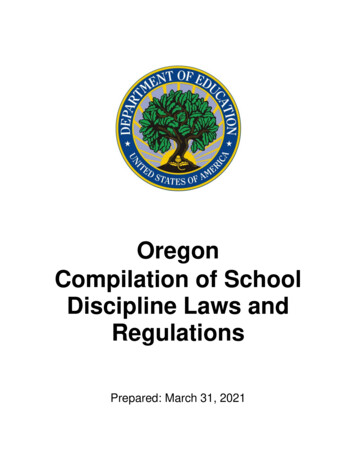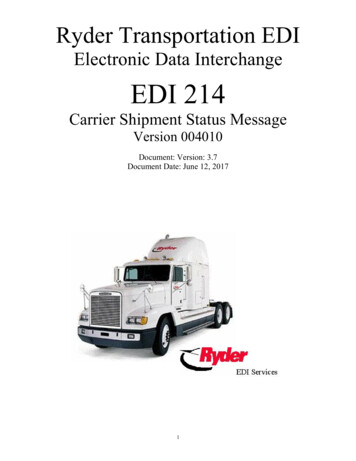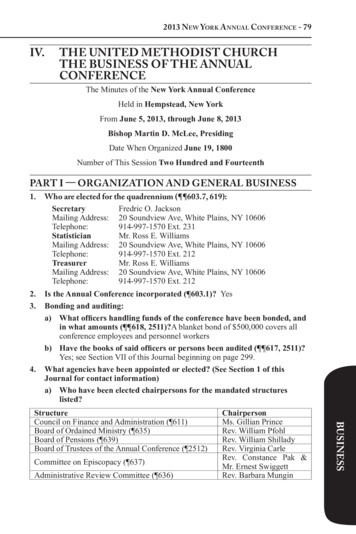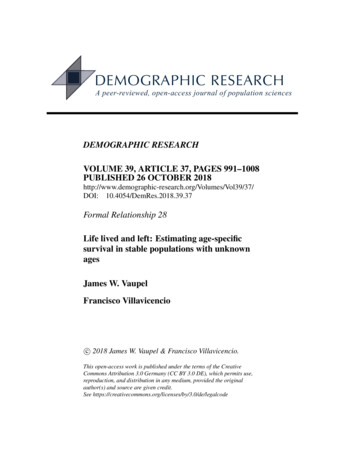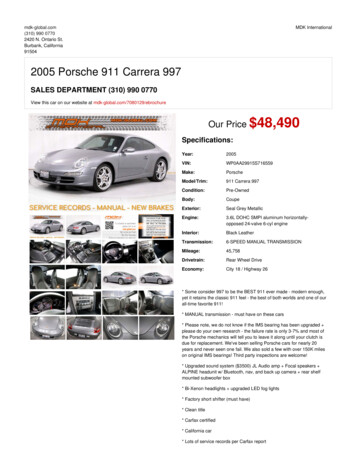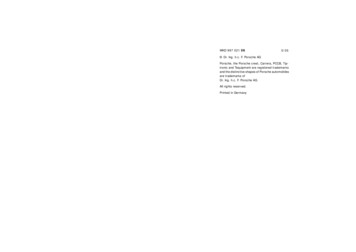
Transcription
WKD 997 021 065/05 Dr. Ing. h.c. F. Porsche AGPorsche, the Porsche crest, Carrera, PCCB, Tiptronic and Tequipment are registered trademarksand the distinctive shapes of Porsche automobilesare trademarks ofDr. Ing. h.c. F. Porsche AG.All rights reserved.Printed in Germany
Dear Owner,We would like to thank you for your purchase of aPorsche Sports car.Judging by the car you have chosen, you are a motorist of a special breed, and you are probably nonovice when it comes to automobiles.Remember however, as with any vehicle, youshould take time to familiarize yourself with yourPorsche and its performance characteristics. Always drive within your own unique capabilities asa driver and your level of experience with yourPorsche. Ensure that anyone else driving yourPorsche does the same. To prevent or minimize injury, always use your safety belts. Never consumealcohol or drugs before or during the operation ofyour vehicle.This Owner’s Manual contains a host of useful information. Please take the time to read this manual before you drive your new Porsche. Become familiar with the operation of your Porsche car formaximum safety and operating pleasure. The better you know your Porsche, the more pleasure youwill experience driving your new car.Always keep your Owner’s Manual in the car, andgive it to the new owner if you ever sell yourPorsche.2A separate Maintenance Booklet explains howyou can keep your Porsche in top driving conditionby having it serviced regularly.A separate Warranty and Customer Information Booklet contains detailed information aboutthe warranties covering your Porsche.For U.S. only:If you believe that your vehicle has a fault whichcould cause a crash, injury or death, you shouldimmediately inform the National Highway TrafficSafety Administration (NHTSA) in addition tonotifying Porsche Cars North America, Inc.(Porsche Cars N.A.).If NHTSA receives similar complaints, it may openan investigation, and if it finds that a safety problem exists in a group of vehicles, it may order a recall and remedy campaign. However, NHTSA cannot become involved in individual problems between you and your dealer, or Porsche Cars N.A.To contact NHTSA, you may either call the AutoSafety Hotline toll-free at 1-(800)-424-9393(or 366-0123 in Washington, D.C. area) or writeto: NHTSA, U.S. Department of Transportation,Washington, D.C. 20590. You can also obtain other information about motor vehicle safety from theHotline.Your car has thousands of parts and componentswhich have been designed and manufactured inaccordance with Porsche’s high standards of engineering quality and safety.Any alteration of the vehicle may negate orinterfere with those safety features built intothe vehicle.Your Porsche is intended to be used in a safe manner obeying the local laws and in the light of driving conditions faced by you, and in accordancewith the instructions provided in this Owner’s Manual.Do not misuse your Porsche by ignoringthose laws and driving conditions, or byignoring the instructions in this manual.Any alteration or misuse of the vehicle canlead to accidents and severe or fatalpersonal injuries.The fitting of racing tires (e.g. slicks) for sportingevents is not approved by Porsche. Very high cornering speeds can be achieved with racing tires.However, the resulting transverse accelerationvalues would jeopardize the adequate supply of oilto the engine.Porsche therefore will not accept any warranty oraccept any liability for damage occurring as a result of non-compliance with this provision.
Regularly check your vehicle for signs ofdamage.Damaged or missing aerodynamic components such as spoilers or underside panelsaffect the driving behavior and thereforemust be replaced immediately.Your car may have all or some of the componentsdescribed in this manual.Should you have difficulty understanding any ofthe explanations of features or equipment installedin your vehicle, contact your authorized Porschedealer. He/She will be glad to assist you. Alsocheck with your dealer on other available optionsor equipment.Throughout this booklet, left is designated as thedriver’s side of the vehicle, and right as the passenger’s side of the vehicle.Text, illustrations and specifications in this manualare based on the information available at the timeof printing.It has always been Porsche’s policy to continuously improve its products. Porsche, therefore, reserves the right to make changes in design andspecification, and to make additions orimprovements in its product without incurring anyobligation to install them on products previouslymanufactured.ImportantFor your own protection and longer service life ofyour car, please follow all operating instructionsand special warnings. These special warnings usethe safety alert symbol, followed by the wordsDanger, Warning and Caution. These specialwarnings contain important messages regardingyour safety and/or the potential for damage toyour Porsche. Ignoring them could result in serious mechanical failure or even physical injury.f Do not alter your Porsche. Any alteration couldcreate dangerous conditions or defeat safetyengineering features built into your car.f Do not misuse your Porsche. Use it safely, andconsistently with the law, according to the driving conditions, and the instructions in this manual.Alteration or misuse of your Porsche couldcause accidents and severe or fatal personalinjuries.Note to ownersIn Canada, this manual is also available in French.To obtain a copy contact your dealer or write to:Note aux proprietairesAu Canada on peut se procurer un exemplaire dece Manuel en français auprès du concessionaireou du:Porsche Cars Canada, Ltd.Automobiles Porsche Canada, LTEE5045 Orbitor DriveBuilding #8, Suite 200Mississauga, OntarioCanada L4W 4Y4Telephone number for customer assistance:1-800-PORSCHE / Option 3We wish you many miles of safe and pleasurabledriving in your Porsche.3
Fuel QualityYour engine is designed to provide optimum performance and fuel economy usingunleaded premium fuel with an octane rating of 98 RON (93 CLC or AKI).Porsche therefore recommends the use of these fuels in your vehicle.Porsche also recognizes that these fuels may not always be available. Be assured that your vehicle will operateproperly on unleaded premium fuels with octane numbers of at least 95 RON (90 CLC or AKI),since the engine’s ”Electronic Oktane knock control“ will adapt the ignition timing, if necessary.Fuels containing alcohol and etherSome areas of the U.S. require oxygenated fuels during certain portions of the year.Oxygenated fuels are fuels which contain alcohols (such as methanol or ethanol) or ether (such as MTBE).Under normal conditions, the amount of these compounds in the fuel will not affect driveability.You may use oxygenated fuels in your Porsche, provided the octane requirements for your vehicle are met.We recommend, however, to change to a different fuel or station if any of the following problems occur with your vehicle:– Deterioration of driveability and performance.– Substantially reduced fuel economy.– Vapor lock and non-start problems, especially at high altitude or at high temperature.– Engine malfunction or stalling.Fuels containing MMTSome North American fuels contain an octane enhancing additive called methylcyclopentadienyl manganese tricarbonyl (MMT).If such fuels are used, your emission control system performance may be negatively affected.The check engine warning lights on your instrument panel may turn on.If this occurs, Porsche recommends you stop using fuels containing MMT.4
Tire Pressures for Cold TiresSummer tires and snow tires 911 Carrera, 911 Carrera S18 inch wheelsfrontrear36 psi (2.5 bar)44 psi (3.0 bar)19 inch wheels, partially loaded(up to 2 persons without luggage)frontrear33 psi (2.3 bar)39 psi (2.7 bar)19 inch wheels, fully loaded(as of 2 persons with luggage)frontrear36 psi (2.5 bar)44 psi (3.0 bar)Summer tires and snow tires 911 Carrera 4, 911 Carrera 4S18 inch and 19 inch wheels, partially loaded(up to 2 persons without luggage)frontrear33 psi (2.3 bar)39 psi (2.7 bar)18 inch and 19 inch wheels, fully loaded(as of 2 persons with luggage)frontrear36 psi (2.5 bar)44 psi (3.0 bar)These tire pressures are valid only for Porsche approved tires.For replacement tires it is imperative that you consult the Technical Data and Tires, Wheelssections of this manual and follow the recommendations found there.5
Porsche and the EnvironmentEnvironmental guidelinesWe develop and produce exclusive sports carswith advanced environmental and safety technology and a great ability to fascinate.Our environmental policy is based on thefollowing principles:– The maximum possible use of environmentaland safety technology that is economically justifiable.– Economical usage of energy and resources.– Involvement of our business partners and contractors in our efforts to protect the environment.– Open dialogue with all social groups.6California Proposition 65 WarningWarning!Engine exhaust, some of its constituents, and certain vehicle components contain or emit chemicals known to the State of California to cause cancer and birth defects or other reproductive harm.In addition, certain fluids contained in vehicles andcertain products of component wear contain oremit chemicals known to the State of California tocause cancer and birth defects or other reproductive harm.ProductionWhether in production or repair, Porsche alwaysrelies on environmentally friendly technology.An example of this is the water-based paint usedin our painting installations.Water-base paints and new painting methods reduce solvent emissions by 70 per cent.The water used in the painting installation is re-circulated. Waste water leaves the Porsche factoryonly after being appropriately treated.A waste-management system has been introducedto reduce the amount of waste while simultaneously increasing the recycling rate.
Environmentally friendly vehiclesModern environmental technology ensures compliance with all emission laws applicable worldwide.These have the following advantages:– Rapid operational readiness of the catalyticconverters ensures low emissions, even inshort-trip operation.– Reliable operation and good emission controlover a long useful life.f Please refer to the chapter “FUEL ECONOMY”on page 207.Recycling – for a Porsche, this is virtuallyan academic questionMore than two-thirds of all Porsches ever built arestill running.Just in case recycling is ever necessary, wetake the following precautionary measures:– Identification of all materials.– Use of recyclable materials.– Reusable components designed for simpleremoval.– These reasons result in a further increase inthe recycling rate which is currently 80 percent.Emission control is built inInnovative engine technology combines high engine performance and environmental compatibility.The engine diagnosis system electronically monitors the components and systems that affect exhaust gases.This continuous monitoring and fault storage enables swift, reliable diagnosis and fault detection.Any fault messages are indicated to the driver bythe ”Check Engine“ warning light and the on-boardcomputer.f Please refer to the chapter “WARNINGS ONTHE INSTRUMENT PANEL AND THE ONBOARD COMPUTER” on page 122.7
Porsche Ceramic Composite Brake(PCCB)The high-performance brake system is designedfor optimal braking effect at all speeds andtemperatures.Certain speeds, braking forces and ambientconditions (such as temperature and humidity)therefore might cause brake noises.Wear on the different components and brakingsystem, such as brake pads and brake discs,depends to a great extent on the individual drivingstyle and the conditions of use and thereforecannot be expressed in actual miles on the road.The values communicated by Porsche are basedon normal operation adapted to traffic. Wearincreases considerably when the vehicle is drivenon race tracks or through an aggressive drivingstyle.f Please consult an authorized Porsche dealerabout the current guidelines in effect beforesuch use of your vehicle.8Setting and operating vehiclecomponents when drivingWarning!There is a danger of accident if you set or operate the on-board computer, radio, navigation system, telephone or other equipmentwhen driving.This could distract you from the traffic andcause you to lose control of the vehicle resulting in serious personal injury or death.f Operate the components while driving only ifthe traffic situation allows you to do so safely.f Carry out any complicated operating or settingprocedures only with the vehicle stationary.Portable Fuel ContainersDanger!Portable fuel containers, full or partiallyempty, may leak, causing an explosion, orresult in fire in case of an accident.f Never carry additional fuel in portable containers in your vehicle.
Engine ExhaustDanger!Engine exhaust is dangerous if inhaled.Engine exhaust fumes have many components which you can smell. They also containcarbon monoxide (CO), which is a colorlessand odorless gas.Carbon monoxide can cause unconsciousness and even death if inhaled.Ground ClearancePlease bear in mind the limited ground clearanceof your car on uneven surfaces, when parking(curbs), on ramps, lifting platforms, towing etc.f Never start or let the engine run in an enclosed, unventilated area.It is not recommended to sit in your car for prolonged periods with the engine on and the carnot moving.9
10
Controls, Instruments13 - 161Shifting Gear163 - 170Mobile Roofs171 - 195Maintenance, Car Care197 - 226Practical Tips, Emergency Service227 - 282Vehicle Identification, Technical Data284 - 302Index304 - 30811
12
Controls, InstrumentsBefore driving off .Break in hints for the first2,000 miles/3,000 kilometers.Keys .Security Wheel Bolts .Doors .Central Locking .Alarm System,Passenger Compartment Monitoring .Power Windows .Inside mirror.Door Mirrors.Rear Window Defogger,Door Mirror Heating .Seat Adjustment .Seat Memory.Heated Seats .Rear Seat Backrests .Steering Wheel Adjustment .Multi-Functional Steering Wheel .Sun Visors.Safety Belts.Airbag Systems .Child Restraint Systems .LATCH SystemChild seat bracket on the passenger’s seat.Child Restraint Anchorages.Rollover Protection System.Parking Aids .Four-Wheel Drive.Retractable Rear Spoiler.Clutch Pedal 8616365Parking Brake. 65Brakes . 66ABS Brake System(Antilock Brake System). 69Sport Mode . 71Porsche Stability Management (PSM). 72Porsche Active SuspensionManagement (PASM) . 75Interior Lights . 76Operation, Instruments . 78Ignition/Starter Switch with anti-theftSteering Lock . 80Starting Procedures . 82Stopping Engine . 83Instrument Panel USA Models . 84Instrument Panel Canada Models. 86Engine oil temperature . 88Automatic Speed Control Indicator light . 88Instrument Illumination. 88Trip Odometer . 89Speedometer . 90Changing over betweenMiles / Kilometers. 90Tachometer. 91Turn Signal Indicator Light . 91High Beam . 91Cooling System . 92Tiptronic .93Fuel . 94Clock . 95Outside temperature . 95Engine Oil Pressure. 96Check EngineWarning Light . 97On-Board Computer (BC) . 98Emergency Flasher Switch. 130Light Switch . 131Welcome Home Lighting . 131Automatic Headlight Beam Adjustment. 132Turn Signal / Headlight Dimmer /Parking light / Flasher Lever . 132Windshield Wiper / Washer Lever . 133Automatic Speed Control. 136Automatic Air Conditioning System . 138Central and Side Vents . 141Fresh-air Intake . 141Ashtray . 142Cigarette Lighter. 143Cupholder . 144Storage in the Passenger Compartment . 146Luggage Compartment Lid and EngineCompartment Lid . 148Luggage Compartment(911 Carrera, 911 Carrera S) . 150Luggage Compartment(911 Carrera 4, 911 Carrera 4S) . 151Trunk Entrapment . 152Fire Extinguisher . 154HomeLink. 155Porsche CommunicationManagement (PCM) . 158Car Telephone andAftermarket Alarms . 161Controls, Instruments13
Dear Porsche OwnerA lot has gone into the manufacture of yourPorsche, including advanced engineering, rigidquality control and demanding inspections.These engineering and safety features will beenhanced by you.the safe driver.– who knows his car and all controls,– who maintains the vehicle properly,– who uses driving skills wisely and alwaysdrives within her/his own capabilities and thelevel of familiarity with the vehicle.You will find helpful hints in this manual on how toperform most of the checks listed on the followingpages.If in doubt, have these checks performed by yourauthorized Porsche dealer.Before driving off.Check the following items firstf Turn the engine off before you attempt anychecks or repairs on the vehicle.f Be sure the tires are inflated correctly.Check tires for damage and tire wear.f See that wheel bolts are properly tightenedand not loose or missing.f Check engine oil level, add if necessary.Make it a habit to have engine oil checked withevery fuel filling.f Check all fluid levels such as windshieldwasher and brake fluid levels.f Be sure the vehicle battery is well charged andcranks the engine properly.f Check all doors and lids for proper operationand latch them properly.f Check, and if necessary replace worn orcracked wiper blades.f See that all windows are clear and unobstructed.f Check air intake slots and area between luggage compartment lid and windshield are freeof snow and ice, so the heater and the windshield wipers work properly.14Controls, Instrumentsf If a child will be riding in the vehicle, checkchild seat/child seat restraint system to ensurethat restraints are properly adjusted.f Check all exterior and interior lights for operation and that the lenses are clean.f Check the headlights for proper aim, and ifnecessary, have them adjusted.f Check under the vehicle for leaks.f Be sure all luggage is stowed securely.Emergency equipmentIt is good practice to carry emergency equipmentin your vehicle.Some of the items you should have are:window scraper, snow brush, container or bag ofsand or salt, emergency light, small shovel, firstaid kit, etc.
In the driver’s seat.On the road.f Check operation of the horn.f Never drive after you have consumed alcoholor drugs.f Position seat for easy reach of foot pedals andcontrols.To reduce the possibility of injury from theairbag deployment, you should always sit backas far from the steering wheel as is practical,while still maintaining full vehicle control.f Adjust the inside and outside rear view mirrors.f Buckle your safety belts.f Check operation of the foot and parking brake.f Check all warning and indicator lights withignition on and engine not running.f Start engine and check all warning displays forwarning symbols.f Never leave an idling car unattended.f Lock doors from inside, especially with children in the car to prevent inadvertent openingof doors from inside or outside.Drive with doors locked.f Always have your safety belt fastened.f Always drive defensively.Expect the unexpected.f Use signals to indicate turns and lane changes.f Turn on headlights at dusk or when the drivingconditions warrant it.f Always keep a safe distance from the vehicle infront of you, depending on traffic, road andweather conditions.f Reduce speed at night and during inclementweather.Driving in wet weather requires caution and reduced speeds, particularly on roads withstanding water, as the handling characteristicsof the vehicle may be impaired due to hydroplaning of the tires.f When parked, always set the parking brake.Move the Tiptronic selector lever to ”P“ or thegearshift lever to reverse or first gear.On hills also turn the front wheels toward thecurb.f When emergency repairs become necessary,move the vehicle well off the road. Turn on theemergency flasher and use other warning devices to alert other motorists. Do not park oroperate the vehicle in areas where the hot exhaust system may come in contact with drygrass, brush, fuel spill or other flammable material.f Make it a habit to have the engine oil checkedafter every fuel filling.f Always observe speed limits and obey roadsigns and traffic laws.f When tired, get well off the road, stop and takea rest. Turn the engine off. Do not sit in the vehicle with engine idling.Please observe the chapter “ENGINE EXHAUST” on Page 9.Controls, Instruments15
Break in hints for the first2,000 miles/3,000 kilometersf Do not participate in motor racing events,sports driving schools, etc. during the first2,000 miles/3,000 kilometers.The following tips will be helpful in obtaining optimum performance from your new Porsche.There may be a slight stiffness in the steering,gear-shifting or other controls during the break-inperiod which will gradually disappear.Despite the most modern, high-precision manufacturing methods, it cannot be completely avoidedthat the moving parts have to wear in with eachother. This wearing-in occurs mainly in the first2,000 miles/3,000 km.Therefore:f Preferably take longer trips.f Avoid frequent cold starts with short-distancedriving whenever possible.f Avoid full throttle starts and abrupt stops.f Do not exceed maximum engine speed of4,200 rpm (revolutions per minute).f Do not run a cold engine at high rpm either inNeutral or in gear.f Do not let the engine labor, especially whendriving uphill. Shift to the next lower gear intime (use the most favorable rpm range).f Never lug the engine in high gear at lowspeeds. This rule applies at all times, not justduring the break-in period.16Controls, InstrumentsBreak in brake pads and brake discsNew brake pads and discs have to be “broken in”,and therefore only attain optimal friction when thecar has covered several hundred miles or km.The slightly reduced braking ability must be compensated for by pressing the brake pedal harder.This also applies whenever the brake pads andbrake discs are replaced.New tiresNew tires do not have maximum traction. Theytend to be slippery.f Break in new tires by driving at moderatespeeds during the first 60 to 120 miles/100 to200 km. Longer braking distances must be anticipated.Engine oil and fuel consumptionDuring the break-in period oil and fuel consumption may be higher than normal.As always, the rate of oil consumption depends onthe quality and viscosity of oil, the speed at whichthe engine is operated, the climate and road conditions, as well as the amount of dilution and oxidation of the lubricant.f Make a habit of checking engine oil with everyfuel filling, add if necessary.
1 Inner door handle2 Power windows3 Door mirror control4 Light switch5 Ignition/starter switch with steering lock6 Turn signal/headlight dimmer,flasher lever7 Operating lever for on-board computer8 Horn9 Emergency flasher switch,central locking switch10 Switches for rear spoiler,Porsche Active Suspension Management(PASM), Sport mode,Porsche Stability Management (PSM)11 Cupholder12 Switch for seat memory13 Diagnostic socket (OBD)14 Lid release15 Seat height adjustment16 Steering-wheel adjustment17 Backrest angle adjustment18 Seat fore and aft adjustmentControls, Instruments17
Never invite car theft!An unlocked car with the key in the ignition lockinvites car theft.A steering wheel lock and a gong alarm arestandard equipment in your Porsche.The gong alarm will sound if you open the driver’sdoor while the key is still in the ignition lock. It isyour reminder to pull the key out of the ignitionlock and to lock the doors.Warning!Any uncontrolled movement of the vehiclemay result in serious personal injury andproperty damage.Never leave your vehicle unattended with thekey in the ignition lock, especially if childrenand/or pets are left unattended in the vehicle. They can operate power windows andother controls. If the engine is left running,they may accidentally engage the shift lever.f Always remove the ignition key.f Always set the parking brake.f Lock the doors with the remote control.18Controls, InstrumentsWarning!Risk of a serious accident.The steering column will lock when you remove the key while you are driving or as thecar is rolling to a stop. You will not be able tosteer the car.f Never remove the key from the steering lockwhile you are driving.To protect your vehicle and your possessionsfrom theft, you should always proceed asfollows when leaving your vehicle:f Close windows.f Close lifting/sliding rooff Close convertible top (with the convertible topopen, the passenger compartment monitoringsystem is always switched off)f Remove ignition key.f Engage steering lock.f Lock glove compartment.f Remove valuables (e.g. car documents, telephone, house keys) from the car.f Lock doors.
KeysReplacement keysImmobilizerf Please observe the chapter “ALARM SYSTEM,PASSENGER COMPARTMENT MONITORING”on Page 26.Replacement car keys can be obtained only fromyour authorized Porsche dealer, and this cansometimes be very time-consuming.You should therefore always keep the spare key onyour person.Keep it in a safe place (e.g. wallet), but under nocircumstances in or on the vehicle.There is a transponder (an electronic component)in the key grip, containing a stored code.When the ignition is switched on, the ignition lockchecks the code.The immobilizer can be deactivated and the engine started only using an authorized ignition key.The key codes of new keys have to be “reported”to the car control unit by your authorized Porschedealer.f Insert the ignition key into the ignition lock.f Please observe the chapter “CENTRAL LOCKING” on Page 22.Two main keys and one spare key are suppliedwith your Porsche.These keys operate all the locks on your vehicle.f Be careful with your car keys: do not part withthem except under exceptional circumstances.f To avoid battery run-down, always remove theignition key from the ignition lock.Disabling key codesIf a key is lost, the key codes can be disabled byan authorized Porsche dealer.All the remaining car keys are required for this purpose.Disabling the code ensures that the car can bestarted only using authorized keys.Notef Please note that the other locks can still beopened with the disabled key.Switching off the immobilizerIf the ignition is left on for more than 2 minuteswithout the engine being started, the immobilizeris reactivated.f If this happens, turn the ignition key back to the3 position before starting the engine.Please observe the chapter “IGNITION/STARTER SWITCH WITH ANTI-THEFTSTEERING LOCK” on Page 80.Switching on the immobilizerf Remove ignition key.Security Wheel Boltsf If wheels have to be removed during a workshop visit, do not forget to hand over the socket for the security wheel bolts along with thecar key.Controls, Instruments19
Switching off the alarm system if it istriggered accidentallyThe remote-control standby functionswitches off after 7 daysUnlocking luggage compartment lidIf the vehicle is not started or unlocked with the remote control within 7 days, the remote controlstandby function is switched off (to prevent discharging of the vehicle battery).f Unlock the vehicle.f Press button 2 for approx. two seconds.If the vehicle was locked, it is unlocked simultaneously with the luggage compartment.In vehicles with seat memory the stored seat anddoor mirror positions are automatically
Summer tires and snow tires 911 Carrera, 911 Carrera S Summer tires and snow tires 911 Carrera 4, 911 Carrera 4S These tire pressures are valid only for Porsche approved tires. For replacement tires it is imperative that you consult the Technical Data and Tires, Wheels sections of this manual and follow the recommendations found there.

